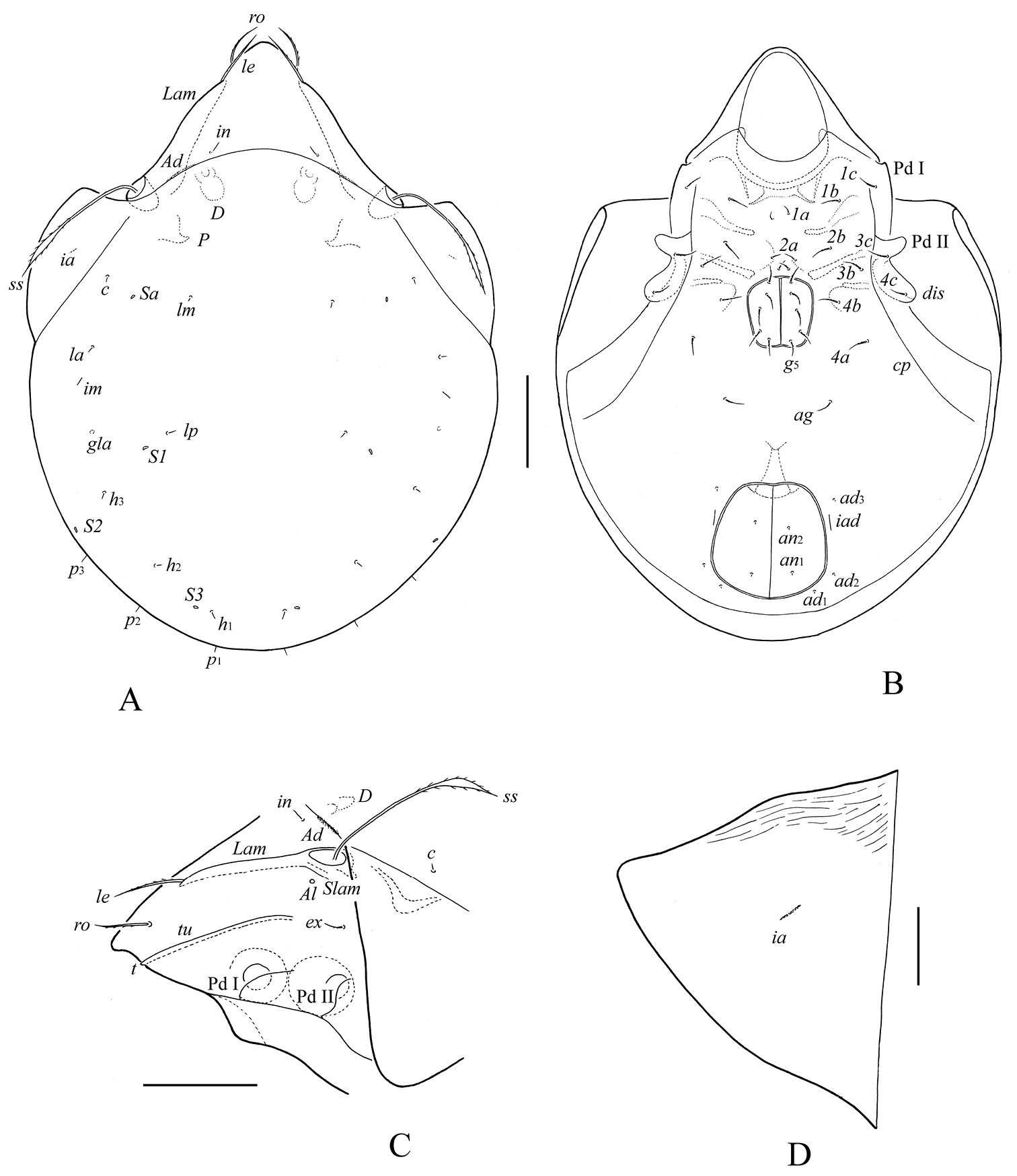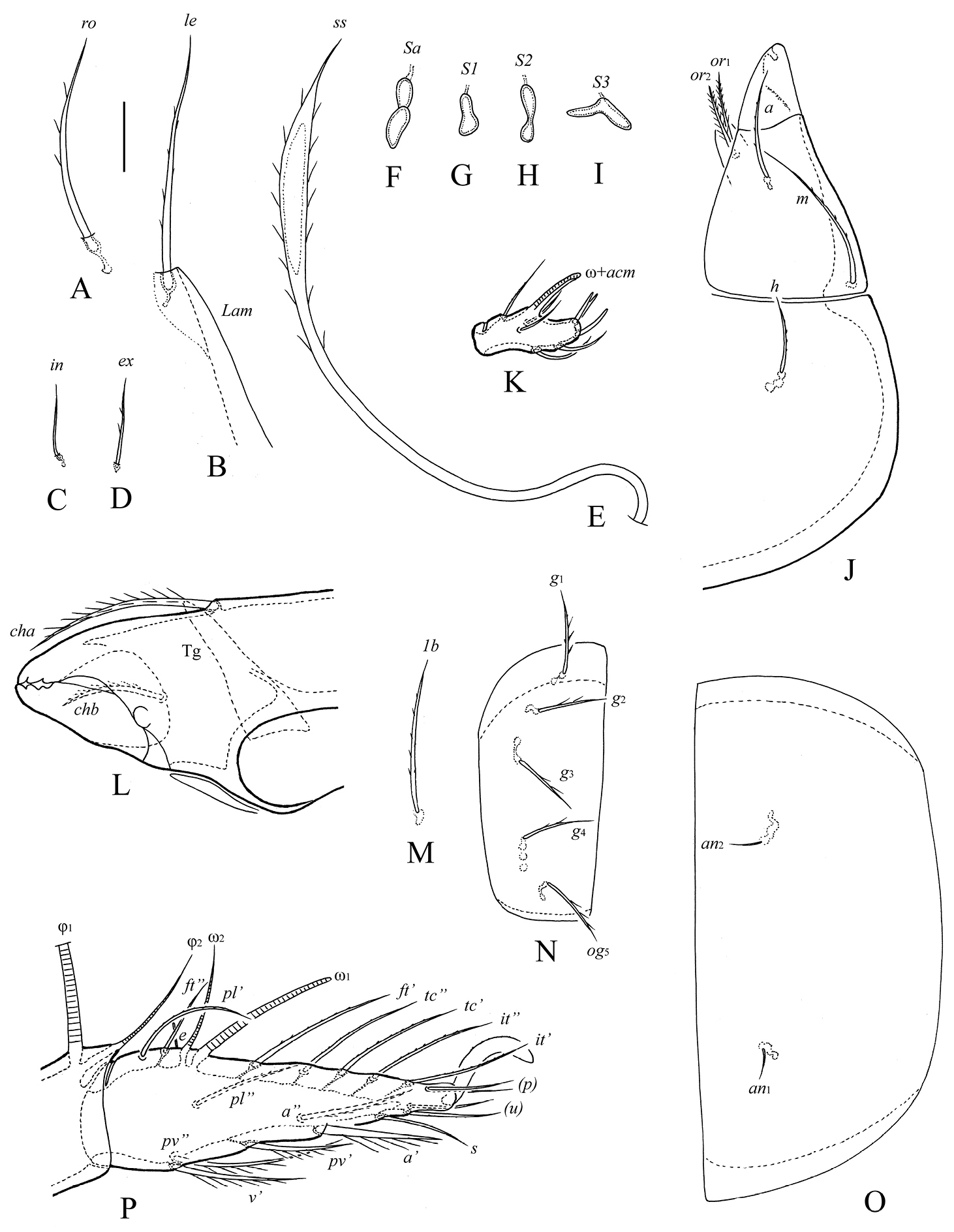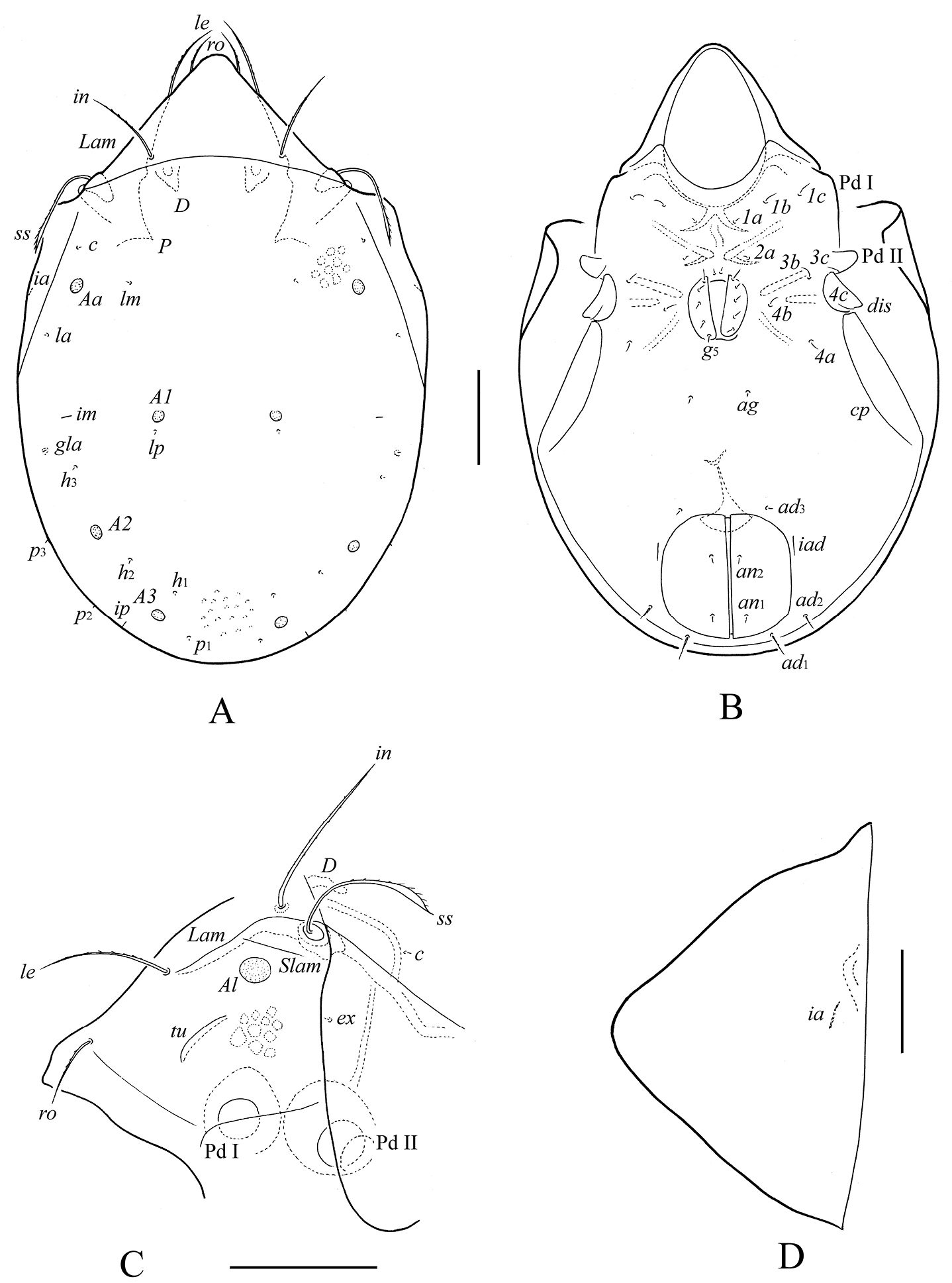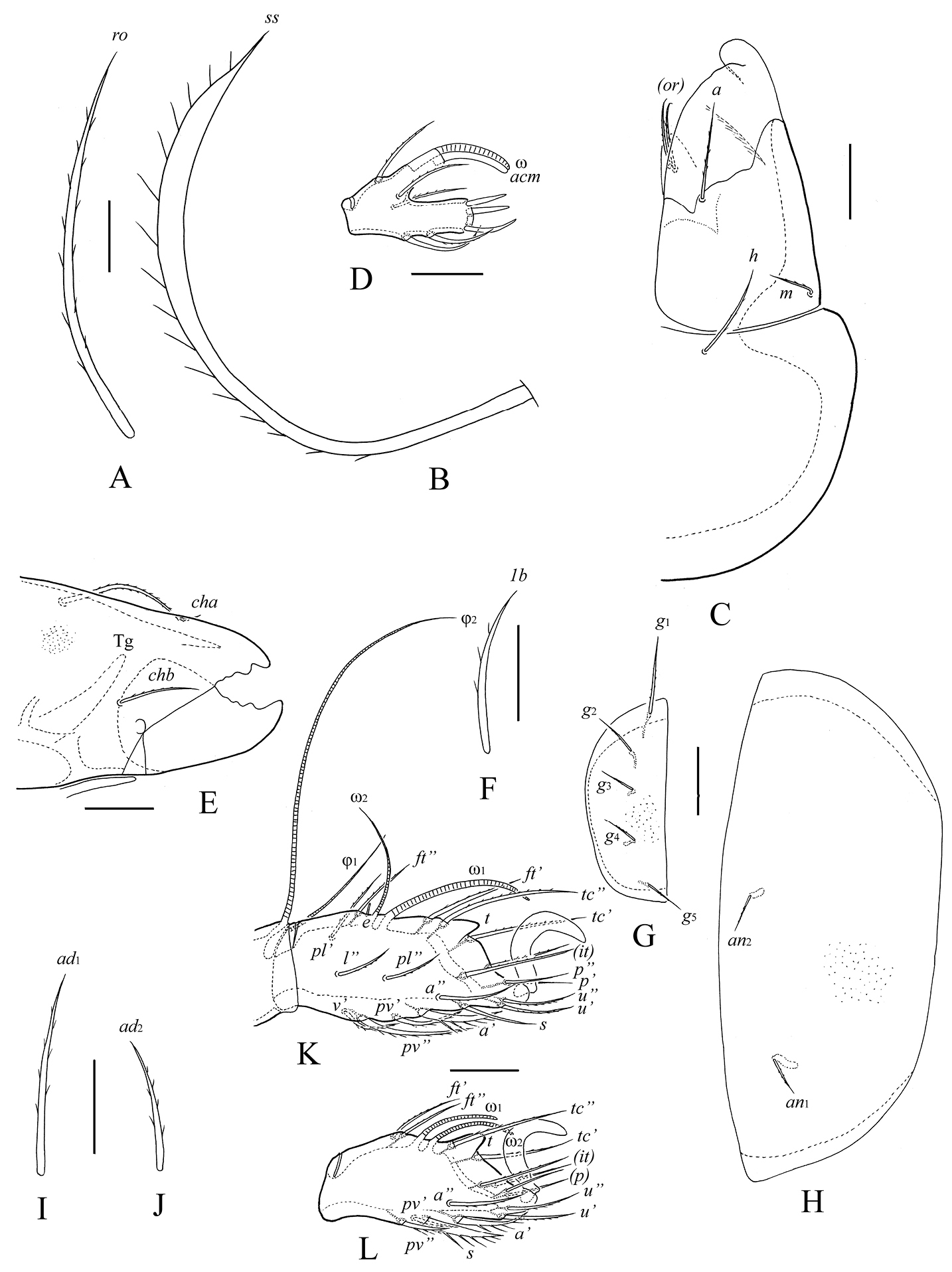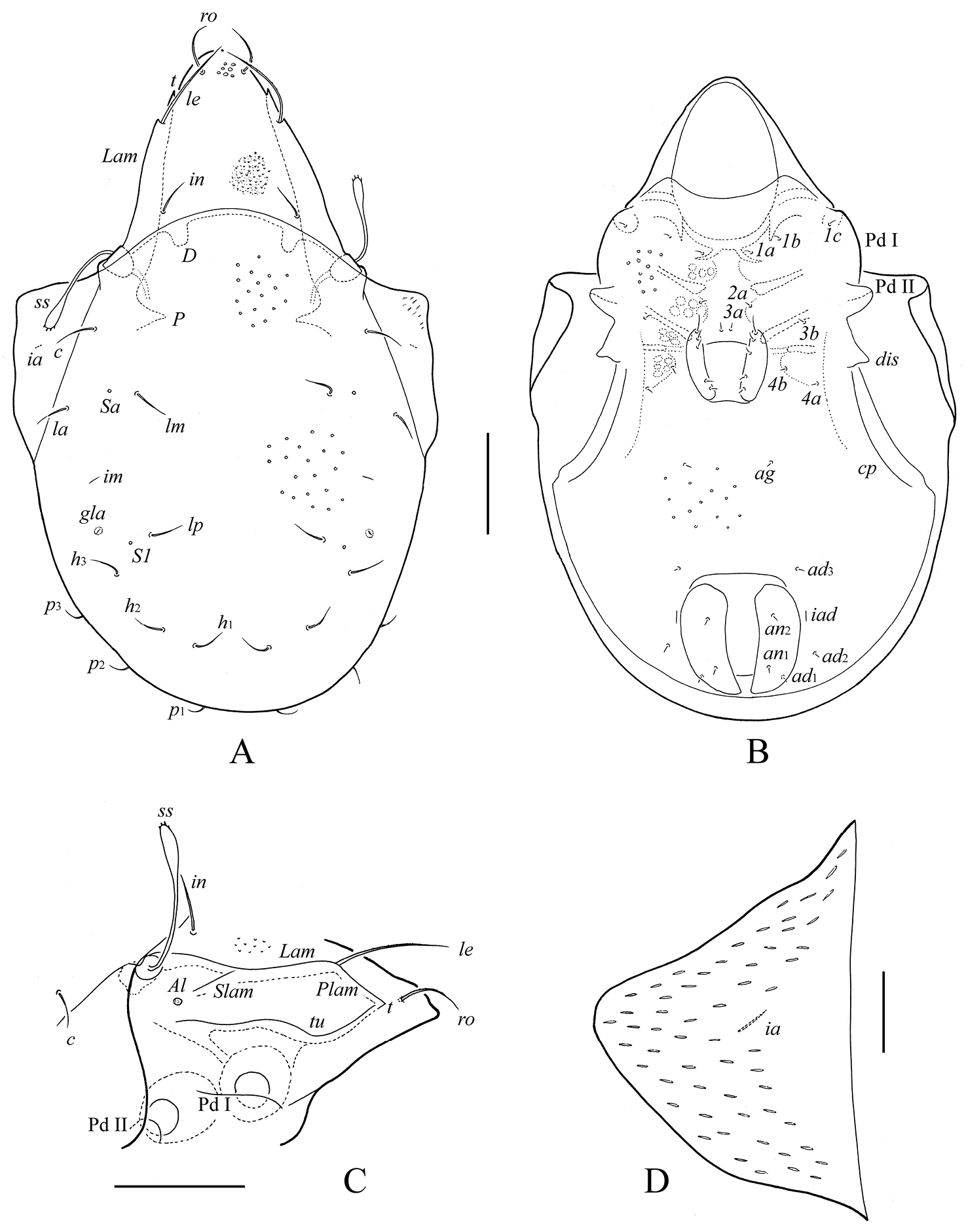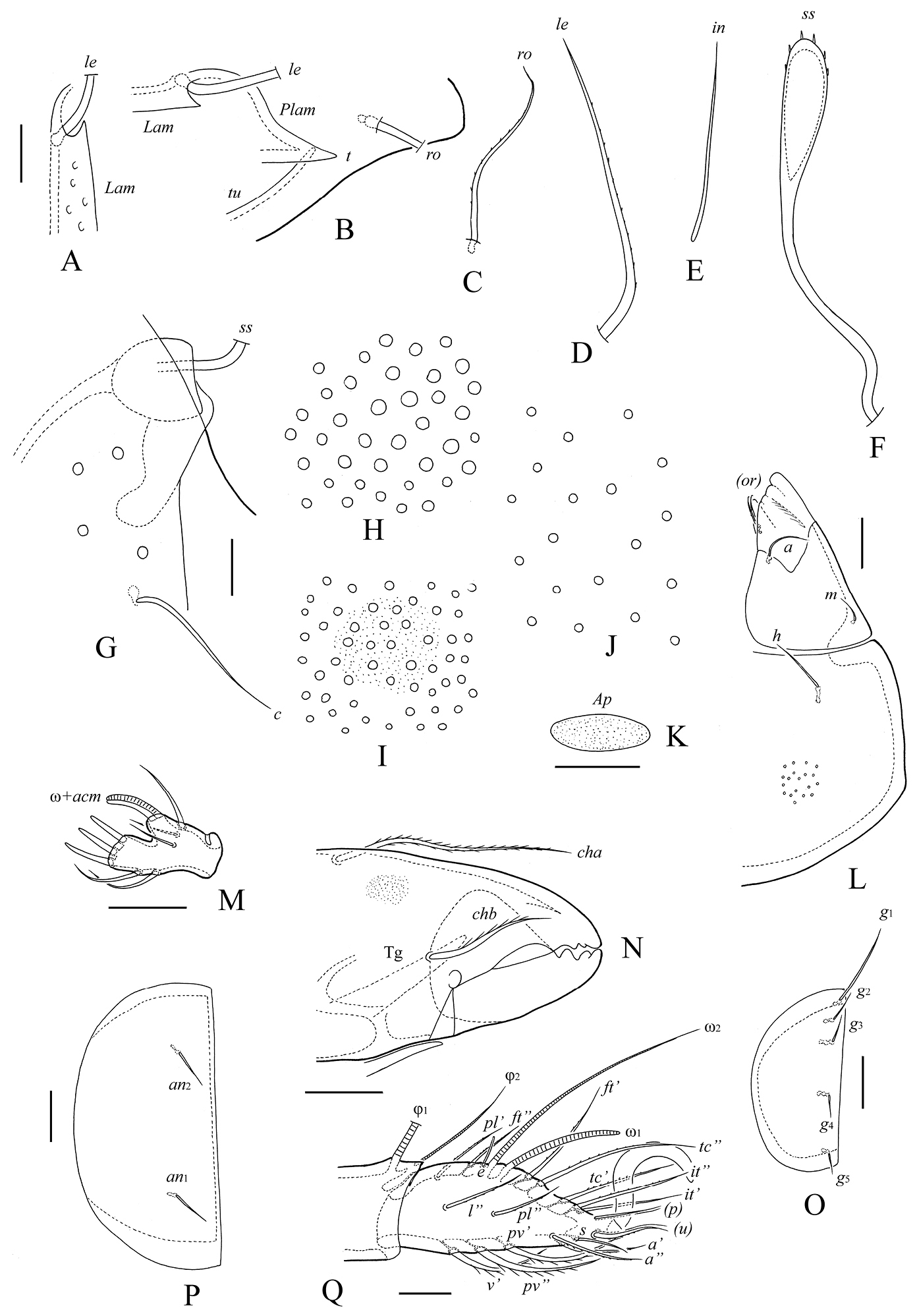






(C) 2013 Sergey G. Ermilov. This is an open access article distributed under the terms of the Creative Commons Attribution License 3.0 (CC-BY), which permits unrestricted use, distribution, and reproduction in any medium, provided the original author and source are credited.
For reference, use of the paginated PDF or printed version of this article is recommended.
Citation: Ermilov SG, Bayartogtokh B, Sandmann D, Marian F, Maraun M (2013) New and little known species of oribatid mites of the family Haplozetidae (Acari, Oribatida) from Ecuador. ZooKeys 346: 43–57. doi: 10.3897/zookeys.346.6436
We described two new species, Haplozetes paraminimicoma sp. n. and Protoribates ecuadoriensis sp. n. from Ecuador. Additionally, a detailed supplementary description of Trachyoribates (Rostrozetes) glaber (Beck, 1965) is given on the basis of Ecuadorian specimens, which was known previously only from Peru. An annotated checklist of all identified taxa of Haplozetidae from Ecuador is presented.
Oribatida, Haplozetidae, new species, Haplozetes, Protoribates, supplementary description, Trachyoribates (Rostrozetes) glaber (Beck, 1965) , Ecuador
The present study is based on the oribatid mite materials collected from the tropical rain forest soils in Ecuador, between 2008 and 2010. This paper is part of our continuing studies (see
In the course of taxonomic identification of the haplozetid mites, we found two new species belonging to the genera Haplozetes Willman, 1935 and Protoribates Berlese, 1908.
The genus Haplozetes was proposed by
The other genus studied here, Protoribates Berlese, 1908 is well defined by
The third genus studied by us, Trachyoribates encompasses two subgenera, Trachyoribates Berlese, 1908 and Rostrozetes Sellnick, 1925, species of both of which are mainly distributed in the tropical regions (see
The main purpose of our paper is to describe and illustrate two new species of Haplozetes and Protoribates. Also, a detailed supplementary description of Trachyoribates (Rostrozetes) glaber (Beck, 1965) is presented on the basis of Ecuadorian specimens.
The study materials are derived from the following two collecting sites:
Ec-1: Southern Ecuador, 3°70'S, 78°58'W, Bombuscaro, Podocarpus National Park, 1050 m a.s.l., upper organic soil layer in mostly undisturbed rain forest, 01.10.2008, 01.04.2009 and 01.08.2010, collected by F. Marian and D. Sandmann.
Ec-2: Southern Ecuador, 3°58'S, 79°50'W, Estación Científica San Francisco, 2000 m a.s.l., upper organic soil layer in mostly undisturbed rain forest, 01.09.2008 and 01.04.2009, collected by F. Marian and D. Sandmann.
Specimens were studied in lactic acid, mounted in temporary cavity slides for the duration of the study, and then stored in 70% ethanol in vials. Body length was measured in lateral view, from the tip of rostrum to the posterior edge of ventral plate. Notogastral width refers to the maximum width in dorsal aspect. Lengths of body setae were measured in lateral aspect. All body measurements are given in micrometers. General terminology used in this paper follows that summarized by
- Haplozetes paraminimicoma sp. n. Locality: Ec-1, Ec-2.
- Protoribates iracemae Pérez-Íñigo & Baggio, 1994. Locality: Ec-1. The species is recorded for the first time from Ecuador.
- Protoribates paracapucinus (Mahunka, 1988). Locality: Ec-1, Ec-2. The species is recorded for the first time from Ecuador and the Neotropical region.
- Protoribates ecuadoriensis sp. n. Locality: Ec-1, Ec-2.
- Trachyoribates (Rostrozetes) glaber (Beck, 1965). Locality: Ec-1. The species are recorded for the first time from Ecuador.
http://zoobank.org/F82D5CC5-9CCB-4B9B-B7EA-C3A03197634C
http://species-id.net/wiki/Haplozetes_paraminimicoma
Figs 1, 2Body size 332–348 × 215–249. Body surface smooth. Rostral and lamellar setae of medium long, with short cilia. Interlamellar setae short, smooth. Sensilli spindle-form, ciliate. Tutoria almost reaching of rostral margin, extending beyond level of insertions of rostral setae. Notogastral setae short, smooth. Genital plates with five pairs of setae. Epimeral, genital and aggenital setae with short cilia. Anal and adanal setae minute. Leg tarsi monodactylous. Leg tarsi I with 19 setae (l’’ absent).
Measurements. Body length: 348 (holotype), 332–348 (four paratypes); notogaster width: 232 (holotype), 215–249 (four paratypes).
Integument. Body color light brownish. Body surface smooth. Anterior part of pteromorphs striate.
Prodorsum. Rostrum rounded. Lamellae (Lam) located dorso-laterally, longer than half of prodorsum, reaching insertions of lamellar setae. Rostral (ro, 28–32) and lamellar (le, 32–36) setae setiform, with several short cilia. Interlamellar setae short (in, 8–12), thin, smooth. A pair of elongate, narrow porose areas Ad present latero-posterior to interlamellar setae (well visible in dissected specimen). Exobothridial setae (ex, 12–16) thin, with one or two cilia. Sensilli longest setae on prodorsum (ss, 94–106), spindle-form, with long stalk, lanceolate head and thin, point tip; distal part of stalk and sensillar head ciliate. Tutoria (tu) thin, almost straight, extending insertions of rostral setae, with small, free tooth (t) distally. Sublamellar lines (Slam) present, short, thin, poorly visible. Sublamellar porose areas (Al) small, rounded (4). Porose areas Am and Ah not observed.
Notogaster. Anterior notogastral margin convex medially. Dorsophragmata (D) and pleurophragmata (P) distinct. Pteromorphs sub-triangular. Ten pairs of notogastral setae short (6), thin, smooth. Four pairs of sacculi (Sa, S1, S2, S3) with small openings; Sa consisting of two adjacent parts, S1 and S2 irregular elongate oval, S3 sub-triangular. Lyrifissures (ia, im, ip, ih, ips) and opisthonotal gland openings (gla) located typically for the genus (see
Gnathosoma. Subcapitulum longer than wide (82 × 61). Subcapitular setae setiform, with short cilia; h (12) shorter than m (28) and a (16). Two pairs of adoral setae (or1, or2, 12) setiform, straight, densely ciliate. Palps (69) with setation 0–2–1–3–9(+ω). Solenidion thickened, weakly dilated distally, coupled with eupathidium (acm). Chelicerae (82) with two setiform, ciliate setae; cha (28) longer and thicker than chb (18). Trägårdh’s organ (Tg) conical.
Epimeral and lateral podosomal regions. Apodemes 1, 2, 3 and sejugals well developed. Epimeral setal formula 3–2(1)–3–3; setae setiform, with short cilia. Setae 2b present in holotype and two paratypes. Medial setae 1a, 2a, 3a (8–10) shorter than others (16–20). Pedotecta I (Pd I), II (Pd II), discidia (dis) and circumpedal carinae (cp) developed typically for the genus (see
Anogenital region. Five pairs of genital (g1–g5, 12) and one pair of aggenital (ag, 16) setae setiform, with short cilia. Two pairs of anal (an1, an2, 4) and three pairs of adanal (ad1–ad3, 4) setae minute. Lyrifissures iad in paraanal position.
Legs. All tarsi with one strong, dorsally weakly serrate claw. Morphology of leg segments, setae and solenidia typical for genus (see
Leg setation and solenidia of Haplozetes paraminimicoma sp. n.
| Leg | Trochanter | Femur | Genu | Tibia | Tarsus |
|---|---|---|---|---|---|
| I | v’ | d, (l), bv’’, v’’ | (l), v’, σ | (l), (v), φ1, φ2 | (ft), (tc), (it), (p), (u), (a), s, (pv), v’, (pl), e, ω1, ω2 |
| II | v’ | d, l1’, l2’, bv’’, v’’ | (l), v’, σ | (l), (v), φ | (ft), (tc), (it), (p), (u), (a), s, (pv), ω1, ω2 |
| III | l’, v’ | d, l’, ev’ | l’, σ | l’, (v), φ | (ft), (tc), (it), (p), (u), (a), s, (pv) |
| IV | v’ | d, ev’ | d, l’ | l’, (v), φ | ft’’, (tc), (p), (u), (a), s, (pv) |
Roman letters refer to normal setae (e to famulus), Greek letters to solenidia. Single prime (’) marks setae on anterior and double prime (’’) setae on posterior side of the given leg segment. Parentheses refer to a pair of setae.
Haplozetes paraminimicoma sp. n., adult: A body dorsally B body ventrally (gnathosoma and legs not illustrated) C prodorsum and anterior part of notogaster laterally D left pteromorph. Scale bar (A–C) 50 μm, scale bar (D) 20 μm.
Haplozetes paraminimicoma sp. n., adult: A rostral seta B lamellar seta and anterior part of lamella C interlamellar seta D exobothridial seta E sensillus F sacullus Sa G sacullus S1 H sacullus S2 I sacullus S3 J left half of subcapitulum K palptarsus L anterior part of chelicera M epimeral seta 1b N right genital plate O left anal plate P tarsus and anterior part of tibia of leg I, left, paraxial view. Scale bar 10 μm.
Holotype (female) and four paratypes (two females and two males): Ec-1.
The holotype (in ethanol) is deposited in the collection of the Zoological Institute of the Russian Academy of Sciences, St. Petersburg, Russia; two paratypes (in ethanol) are deposited in the collection of the Siberian Zoological Museum, Novosibirsk, Russia; two paratypes (in ethanol) are in the personal collection of the first author.
The prefix para is Latin meaning “near” and refers to the similarity between the new species and the species, Haplozetes minimicoma Beck, 1964.
In having the combination of main morphological characters (sensilli spindle-form, ciliate; interlamellar, notogastral and ano-adanal setae short; leg tarsi with one claw), Haplozetes paraminimicoma sp. n. is most similar to Haplozetes minimicoma Beck, 1964 from the Neotropical region and India (see
http://zoobank.org/B13B53C5-6850-4437-A493-5E7885A44D58
http://species-id.net/wiki/Protoribates_ecuadoriensis
Figs 3, 4Body size 547–647 × 332–431. Prodorsal setae long, setiform, barbed. Exobothridial setae minute. Sensilli with long stalk, lanceolate head and thin, point tip; distal part of stalk and sensillar head ciliate. Sublamellar porose areas large, oval. Notogastral porose areas of medium size, oval. Notogastral setae short. Adanal setae ad1 longer than ad2, ad2 longer than ad3.Legs monodactylous. Leg tarsi I, II with large dorsal tubercles. Tarsi I with 20 setae.
Measurements. Body length: 630 (holotype), 547–647 (five paratypes); notogaster width: 415 (holotype), 332–431 (five paratypes).
Integument. Body color light brownish to brown. Body surface microgranulate (visible only under high magnification).
Prodorsum. Rostrum rounded. Lamellae located dorso-laterally, not longer than half of prodorsum, hardly reaching insertions of lamellar setae. Rostral (49–57), lamellar (86–94) and interlamellar setae (123–135) setiform, barbed. A pair of elongate, narrow porose areas Ad present latero-posterior to interlamellar setae (visible under high magnification in dissected specimen). Exobothridial setae minute (4), thin, smooth. Sensilli (102–108) with long stalk, lanceolate head and thin, pointed tip; distal part of stalk and sensillar head ciliate. Tutoria short, narrow, slightly arched distally. Sublamellar lines short, very thin, straight, poorly visible. Sublamellar porose areas large, oval (20 × 16). Porose areas Am and Ah not observed.
Notogaster. Anterior notogastral margin convex medially. Dorsophragmata and pleurophragmata distinct. Pteromorphs sub-triangular. Ten pairs of notogastral setae short (4–6), thin, smooth. Four pairs of porose areas of medium size, oval: Aa (16–20 × 12–16) slightly larger than A1, A2 and A3 (10–14 × 8–12). Setae lp inserted posteriorly to A1. Lyrifissures (ia, im, ip, ih, ips) and opisthonotal gland openings located typically for the genus (see
Gnathosoma. Subcapitulum longer than wide (147–164 × 102–110). Subcapitular setae setiform, barbed; h and a (both 24–28) longer than m (10–14). Two pairs of adoral setae (16–20) setiform, barbed. Palps (90) with setation 0–2–1–3–9(+ω). Solenidion thickened, coupled with eupathidium. Chelicerae (147–164) with two setiform, barbed setae; cha (41–45) longer and thicker than chb (24–28). Trägårdh’s organ conical.
Epimeral and lateral podosomal regions. Apodemes 1, 2, 3 and sejugals well developed. Epimeral setal formula 3–1–3–3; setae setiform, slightly barbed. Medial setae 1a, 2a, 3a (12–14) shorter than others (20–24). Pedotecta I, II, discidia and circumpedal carinae developed typically for the genus (see
Anogenital region. Five pairs of genital (g1, 18–24, g2–g5, 12–16), one pair of aggenital (12), two pairs of anal (12) and three pairs of adanal (ad1, 22–24, ad2, 14–16, ad3, 12) setae setiform, slightly barbed. Lyrifissures iad in paraanal position.
Legs. All tarsi monodactylous. Morphology of leg segments, setae and solenidia typical for genus (see
Leg setation and solenidia of Protoribates ecuadoriensis, sp. n. (same data for Trachyoribates (Rostrozetes) glaber).
| Leg | Trochanter | Femur | Genu | Tibia | Tarsus |
|---|---|---|---|---|---|
| I | v’ | d, (l), bv’’, v’’ | (l), v’, σ | (l), (v), φ1, φ2 | (ft), (tc), (it), (p), (u), (a), s, (pv), v’, (pl), l’’, e, ω1, ω2 |
| II | v’ | d, l1’, l2’, bv’’, v’’ | (l), v’*, σ | (l), (v), φ | (ft), (tc), (it), (p), (u), (a), s, (pv), ω1, ω2 |
| III | l’, v’ | d, l’, ev’ | l’, σ | l’, (v), φ | (ft), (tc), (it), (p), (u), (a), s, (pv) |
| IV | v’ | d, ev’ | d, l’ | l’, (v), φ | ft’’, (tc), (p), (u), (a), s, (pv) |
See Table 1 for explanations. * – seta v’ absent in Trachyoribates (Rostrozetes) glaber.
Protoribates ecuadoriensis sp. n., adult: A body dorsally B body ventrally (gnathosoma and legs not illustrated) C prodorsum and anterior part of notogaster laterally D left pteromorph. Scale bar (A–C) 100 μm, scale bar (D) 50 μm.
Protoribates ecuadoriensis sp. n., adult: A rostral seta B sensillus C left half of subcapitulum D palptarsus E anterior part of chelicera F epimeral seta 1b G right genital plate H left anal plate I adanal seta ad1J adanal seta ad2K tarsus and anterior part of tibia of leg I, right, antiaxial view L tarsus of leg II, right, antiaxial view. Scale bar (A, B, D, F, I, J) 10 μm, scale bar (C, E, G, H, K, L) 20 μm.
Holotype (female) and five paratypes (two females and three males): Ec-1.
The holotype (in ethanol) is deposited in the collection of the Zoological Institute of the Russian Academy of Sciences, St. Petersburg, Russia; three paratypes (in ethanol) are deposited in the collection of the Siberian Zoological Museum, Novosibirsk, Russia; two paratypes (in ethanol) are in the personal collection of the first author.
The specific name “ecuadoriensis” refers to the country of origin, Ecuador.
In having the combination of main morphological characters (monodactylous legs; body of medium size; prodorsal setae long, simple, barbed; sensilli long, with lanceolate, ciliate head; four pairs of porose areas oval; adanal setae ad1 longer than ad2, ad2 longer than ad3), Protoribates ecuadoriensis sp. n. is most similar to Protoribates oblongus (Ewing, 1909) from the Nearctic region (see
http://species-id.net/wiki/Trachyoribates_glaber
Figs 5, 6Body size 307–365 × 199–232. Body surface foveolate. Rostral and lamellar setae of medium size, slightly barbed; interlamellar setae short, thin, smooth. Sensilli clavate; sensillar head with several barbs distally. Tutoria fused distally to prolamellar lines. Anterior notogastral margin regular convex. Notogastral setae of medium size, smooth. Postanal porose area present. Ventral setae short, smooth. Legs monodactylous.
Measurements. Body length: 307–365 (eight specimens); notogaster width: 199–232 (eight specimens).
Integument. Body color light brownish. Body surface foveolate (diameter of foveolae up to 4 on rostrum, up to 3 on notogaster and ventral side, up to 2 on medio-basal part of prodorsum). Foveolae located densely on prodorsum, but sparse on notogaster and ventral side. Also microgranules present on prodorsum.
Prodorsum. Rostrum rounded. Lamellae located dorso-laterally, longer than half of prodorsum, reaching insertion of lamellar setae. Prolamellar lines well developed. Rostral (32–41) and lamellar (49–57) setae setiform, slightly barbed. Interlamellar setae thin, smooth, shorter (28–32) and thinner than lamellar setae. A pair of elongate, narrow porose areas Ad present latero-posterior to interlamellar setae (visible only in dissected specimen). Exobothridial setae and their alveoli absent. Sensilli longest setae on prodorsum (61–73), with long stalk and clavate head; sensillar head with several barbs distally. Tutoria long, fused distally to prolamellar lines forming point tip (t), not reaching to insertions of rostral setae. Sublamellar lines short, thin, straight. Sublamellar porose areas small, rounded (4–8). Porose areas Am and Ah not observed.
Notogaster. Anterior notogastral margin regular convex. Dorsophragmata and pleurophragmata distinct. Pteromorphs sub-triangular. Notogastral setae represented by 10 pairs; they of medium size (p1–p3, 16–20; others, 24–32), thin, smooth. Four pairs of sacculi (Sa, S1, S2, S3) with small openings, but S2 and S3 visible only in dissected specimens. Lyrifissures and opisthonotal gland openings located typically for the genus (see
Gnathosoma. Subcapitulum longer than wide (73–82 × 61–69). Subcapitular setae setiform, smooth; h (12) longer than m (6) and a (10). Two pairs of adoral setae (8) setiform, slightly barbed. Palps (41–45) with setation 0–2–1–3–9(+ω). Solenidion thickened, attached with eupathidium. Chelicerae (73–82) with two setiform, ciliate setae; cha (28–32) longer than chb (16–20). Trägårdh’s organ conical.
Epimeral and lateral podosomal regions. Apodemes 1, 2, 3 and sejugals well developed. Epimeral setal formula 3–1–3–3; setae short (4–6), setiform, smooth. Pedotecta I, II, discidia and circumpedal carinae developed typically for the genus (
Anogenital region. Five pairs of genital (g1, 14, g2–g5, 6–8), one pair of aggenital (6–8), two pairs of anal (6–8) and three pairs of adanal (6–8) setiform, thin, smooth. Lyrifissures iad in paraanal position.
Legs. All tarsi with one strong, smooth claw. Formulae of leg setation and solenidia: I (1–5–3–4–20) [1–2–2], II (1–5–2–4–15) [1–1–2], III (2–3–1–3–15) [1–1–0], IV (1–2–2–3–12) [0–1–0]; homology of setae and solenidia indicated in Table 2.
Trachyoribates (Rostrozetes) glaber (Beck, 1965), adult: A body dorsally B body ventrally (gnathosoma and legs not illustrated) C prodorsum and anterior part of notogaster laterally D left pteromorph. Scale bar (A–C) 50 μm, scale bar (D) 20 μm.
Trachyoribates (Rostrozetes) glaber (Beck, 1965), adult: A anterior part of lamella (medio-distal part of lamellar seta not illustrated) B anterior part of lamella and tutoria, and prolamellar line dorso-laterally (medio-distal part of rostral and lamellar seta not illustrated) C rostral seta D lamellar seta E interlamellar seta F sensillus G bothridium and notogastral seta c H foveolae on rostrum I foveolae in central part of prodorsum J foveolae on notogaster K postanal porose area L left half of subcapitulum M palptarsus N anterior part of chelicera O right genital plate P right anal plate Q tarsus and anterior part of tibia of leg I, right, antiaxial view. Scale bar 10 μm.
Eight specimens (five females and three males): Ec-1.
Actually the name of this species was first made available by
We cordially thank Prof. Dr. Roy A. Norton (State University of New York, College of Environmental Science and Forestry, Syracuse, USA) who studied for us the specimens of Protoribates oblongus from personal collection, and Prof. Dr. Gerd Weigmann (Free University of Berlin, Institute of Zoology, Berlin, Germany) for valuable comments.
Oribatid mites were investigated as part of the Research Unit “Biodiversity and sustainable management of a megadiverse mountain ecosystem in South Ecuador”, subproject “Soil fauna: Diversity and functioning” headed by Mark Maraun and Stefan Scheu; financial support by the German Research Foundation is gratefully acknowledged (RU 816).
